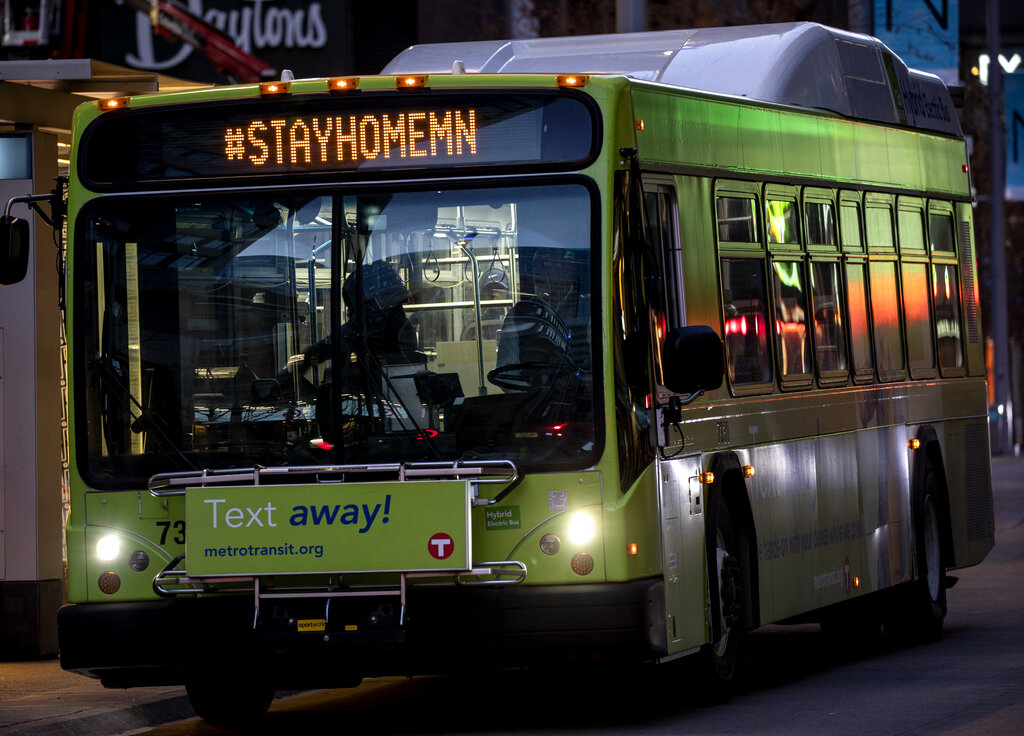
In this Monday, March 23, 2020, photo, Metro Transit busses travel with the hashtag #STAYHOMEMN during the coronavirus outbreak on Nicollet Mall in downtown Minneapolis. (Carlos Gonzalez/Star Tribune via AP)
MINNEAPOLIS (AP) — Gov. Tim Walz on Wednesday ordered Minnesota residents in nonessential jobs to stay at home for two weeks in an effort to slow the spread of COVID-19 and prevent the coronavirus from overwhelming the state’s health care system.
The governor’s order begins at midnight Friday. He said the restrictions were critical to allow the state to protect its most vulnerable people and give time to build up the state’s capacity to handle a flood of infections.
“I’m asking for your patience, your cooperation and your understanding,” Walz said in a live video message. “My pledge to you is to use the valuable time you’re giving us.”
Walz had held off on issuing the order because he wanted to see data and modeling to show whether it would make enough of a difference to justify the disruptions that could last for weeks or months.
Several other states and countries have issued shelter-in-place orders or closed all nonessential businesses, sometimes under different names, such as “safer at home” in neighboring Wisconsin. Most states that have imposed the restrictions have allowed people out to go to supermarkets, pharmacies and doctors, or for exercise. They’ve made exceptions for workers deemed essential.
THIS IS A BREAKING NEWS ALERT. AP’s earlier story follows below.
Minnesota Gov. Tim Walz was preparing to address the state on Wednesday to announce new restrictions as the state fights to slow the spread of COVID-19.
His announcement was set for 2 p.m.
Walz shuttered bars and restaurants on March 17, but had taken a cautious approach to imposing additional restrictions on Minnesota residents and businesses. Some states have imposed shelter-in-place orders, but Walz said Tuesday that he was hoping to find a “smarter and more targeted way to respond.”
The Democratic governor also warned that the fight would extend “well beyond Easter.”
The state’s count of confirmed COVID-19 cases rose to 287 on Wednesday, up 25 from a day earlier, with 26 hospitalized cases, up 11 from Tuesday. Officials have stressed that the real total of Minnesota residents with the disease is much higher because many people don’t qualify for testing. But more than 11,000 people have now been tested in Minnesota, the Health Department said.
For most people, the new coronavirus causes mild or moderate symptoms, such as fever and cough that clear up in two to three weeks. For some, especially older adults and people with existing health problems, it can cause more severe illness, including pneumonia, and death.
In other developments, Minnesota lawmakers were preparing to return to the Capitol on Thursday to beef up the state’s fight against COVID-19 and help residents cope with the economic hardships. Details of the relief package have not been announced.
Also, Minneapolis-based Target announced new measures Wednesday to protect shoppers and store employees. Checkout lanes will be cleaned after each sale. New signs and floor decals will encourage shoppers to keep their distance from each other. Target will suspend sales of reusable bags and ask guests who bring their own bags to pack their own items at checkout. Also, Target will stop accepting in-store merchandise returns and exchanges for three weeks, though it will honor returns that expire during that period.
